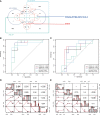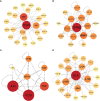ZNF384: A Potential Therapeutic Target for Psoriasis and Alzheimer's Disease Through Inflammation and Metabolism
- PMID: 35669784
- PMCID: PMC9163351
- DOI: 10.3389/fimmu.2022.892368
ZNF384: A Potential Therapeutic Target for Psoriasis and Alzheimer's Disease Through Inflammation and Metabolism
Abstract
Background: Psoriasis is an immune-related skin disease notable for its chronic inflammation of the entire system. Alzheimer's disease (AD) is more prevalent in psoriasis than in the general population. Immune-mediated pathophysiologic processes may link these two diseases, but the mechanism is still unclear. This article aimed to explore potential molecular mechanisms in psoriasis and AD.
Methods: Gene expression profiling data of psoriasis and AD were acquired in the Gene Expression Omnibus (GEO) database. Gene Set Enrichment Analysis (GSEA) and single-sample GSEA (ssGSEA) were first applied in two datasets. Differentially expressed genes (DEGs) of two diseases were identified, and common DEGs were selected. Kyoto Encyclopedia of Genes and Genomes (KEGG) pathway enrichment analysis was performed to explore common biological pathways. Signature transcription factors (STFs) were identified and their diagnostic values was calculated by receiver operating characteristic (ROC) curve analysis in the exploration cohort and verified in the validation cohort. The expression levels of STFs were further investigated in the validation cohort and the GTEx Portal Database. Additionally, four kinds of interaction analysis were performed: correlation analysis among STFs, gene-gene, chemical-protein, and protein-ligand interaction analyses. In the end, we predicted the transcription factor that potentially regulates STFs.
Results: Biosynthesis and metabolic pathways were enriched in GSEA analysis. In ssGSEA analysis, most immunoreaction gene lists exhibited differential enrichment in psoriasis cases, whereas three receptor-related gene lists did in AD. The KEGG analysis of common DEGs redetermined inflammatory and metabolic pathways essential in both diseases. 5 STFs (PPARG, ZFPM2, ZNF415, HLX, and ANHX) were screened from common DEGs. The ROC analysis indicated that all STFs have diagnostic values in two diseases, especially ZFPM2. The correlation analysis, gene-gene, chemical-protein, and protein-ligand interaction analyses suggested that STFs interplay and involve inflammation and aberrant metabolism. Eventually, ZNF384 was the predicted transcription factor regulating PPARG, ZNF415, HLX, and ANHX.
Conclusions: The STFs (PPARG, ZFPM2, ZNF415, HLX, and ANHX) may increase the morbidity rate of AD in psoriasis by initiating a positive feedback loop of excessive inflammation and metabolic disorders. ZNF384 is a potential therapeutic target for psoriasis and AD by regulating PPARG, ZNF415, HLX, and ANHX.
Keywords: Alzheimer’s disease; inflammation; metabolic disorders; psoriasis; transcription factors.
Copyright © 2022 Liu, Yuan, Su, Liu, Zhuang and Chen.
Conflict of interest statement
The authors declare that the research was conducted in the absence of any commercial or financial relationships that could be construed as a potential conflict of interest.
Figures










Similar articles
-
Gene expression analysis in endometriosis: Immunopathology insights, transcription factors and therapeutic targets.Front Immunol. 2022 Nov 30;13:1037504. doi: 10.3389/fimmu.2022.1037504. eCollection 2022. Front Immunol. 2022. PMID: 36532015 Free PMC article.
-
Identification of PPARG as key gene to link coronary atherosclerosis disease and rheumatoid arthritis via microarray data analysis.PLoS One. 2024 Apr 4;19(4):e0300022. doi: 10.1371/journal.pone.0300022. eCollection 2024. PLoS One. 2024. PMID: 38573982 Free PMC article.
-
Key genes and immune infiltration patterns and the clinical implications in psoriasis patients.Skin Res Technol. 2024 Aug;30(8):e13889. doi: 10.1111/srt.13889. Skin Res Technol. 2024. PMID: 39120060 Free PMC article.
-
Identification of common core ion channel genes in epilepsy and Alzheimer's disease.Ir J Med Sci. 2024 Feb;193(1):417-424. doi: 10.1007/s11845-023-03447-x. Epub 2023 Jul 21. Ir J Med Sci. 2024. PMID: 37477849 Review.
-
Literature Overview of the Relation Between Psoriasis and Alzheimer.Neuropsychiatr Dis Treat. 2023 Feb 28;19:461-468. doi: 10.2147/NDT.S403854. eCollection 2023. Neuropsychiatr Dis Treat. 2023. PMID: 36879948 Free PMC article. Review.
Cited by
-
Modulating the RPS27A/PSMD12/NF-κB pathway to control immune response in mouse brain ischemia-reperfusion injury.Mol Med. 2024 Jul 22;30(1):106. doi: 10.1186/s10020-024-00870-3. Mol Med. 2024. PMID: 39039432 Free PMC article.
-
The pivotal role of ZNF384: driving the malignant behavior of serous ovarian cancer cells via the LIN28B/UBD axis.Cell Biol Toxicol. 2024 Nov 19;40(1):100. doi: 10.1007/s10565-024-09938-6. Cell Biol Toxicol. 2024. PMID: 39562372 Free PMC article.
-
Single-cell multiomic analysis unveils the immune landscape dynamics of graves' ophthalmopathy.Commun Biol. 2025 May 12;8(1):732. doi: 10.1038/s42003-025-08115-7. Commun Biol. 2025. PMID: 40355702 Free PMC article.
-
A novel Alzheimer's disease prognostic signature: identification and analysis of glutamine metabolism genes in immunogenicity and immunotherapy efficacy.Sci Rep. 2023 Apr 27;13(1):6895. doi: 10.1038/s41598-023-33277-x. Sci Rep. 2023. PMID: 37106067 Free PMC article.
-
Single-nucleus RNA sequencing-based construction of a hippocampal neuron atlas in mice with epileptic cognitive impairment.iScience. 2024 Sep 28;27(10):111065. doi: 10.1016/j.isci.2024.111065. eCollection 2024 Oct 18. iScience. 2024. PMID: 39635132 Free PMC article.
References
MeSH terms
Substances
LinkOut - more resources
Full Text Sources
Medical

